Southern Cross University Cruise Business Take-Home Test, 2019
VerifiedAdded on 2022/10/07
|8
|2560
|23
Homework Assignment
AI Summary
This take-home test for the MNG 10291 Cruise Business course at Southern Cross University examines the evolution of cruise ship dining models from traditional two-sitting arrangements to contemporary, personalized options, analyzing the implications for cruise ship catering and inventory management. The assignment also explores the significance of onboard revenue generation, discussing the shift towards dynamic pricing models and the influence of this trend on cruise ship design and customer valuation. Furthermore, the test addresses critical aspects of cruise ship security, including the captain's authority, the link between piracy and terrorism, current and future security measures, and the differentiation between Marine and Hotel Operations departments. The analysis incorporates references from academic sources, industry reports, and relevant articles, providing a comprehensive overview of the cruise business's key operational and strategic elements.
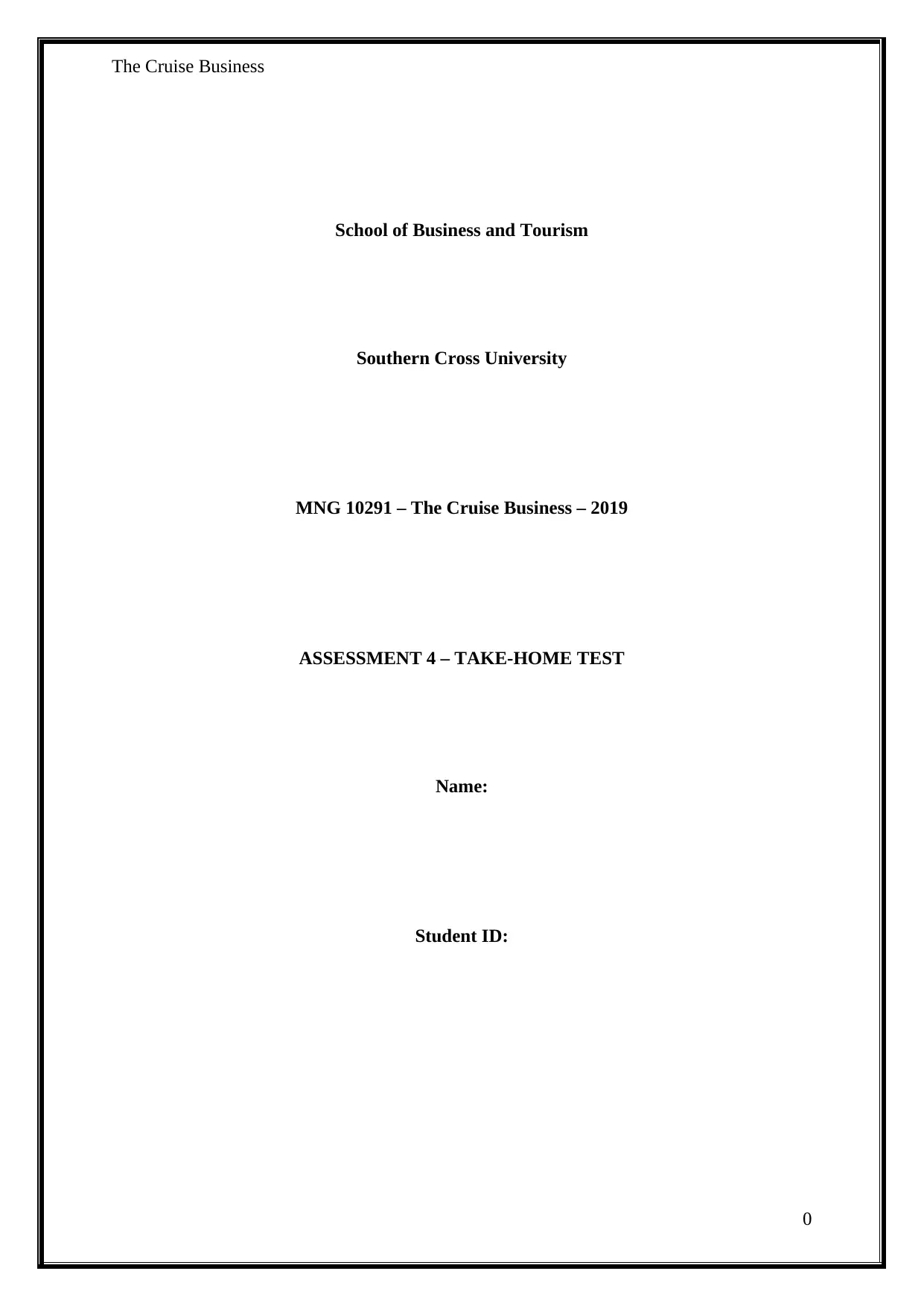
The Cruise Business
School of Business and Tourism
Southern Cross University
MNG 10291 – The Cruise Business – 2019
ASSESSMENT 4 – TAKE-HOME TEST
Name:
Student ID:
0
School of Business and Tourism
Southern Cross University
MNG 10291 – The Cruise Business – 2019
ASSESSMENT 4 – TAKE-HOME TEST
Name:
Student ID:
0
Paraphrase This Document
Need a fresh take? Get an instant paraphrase of this document with our AI Paraphraser
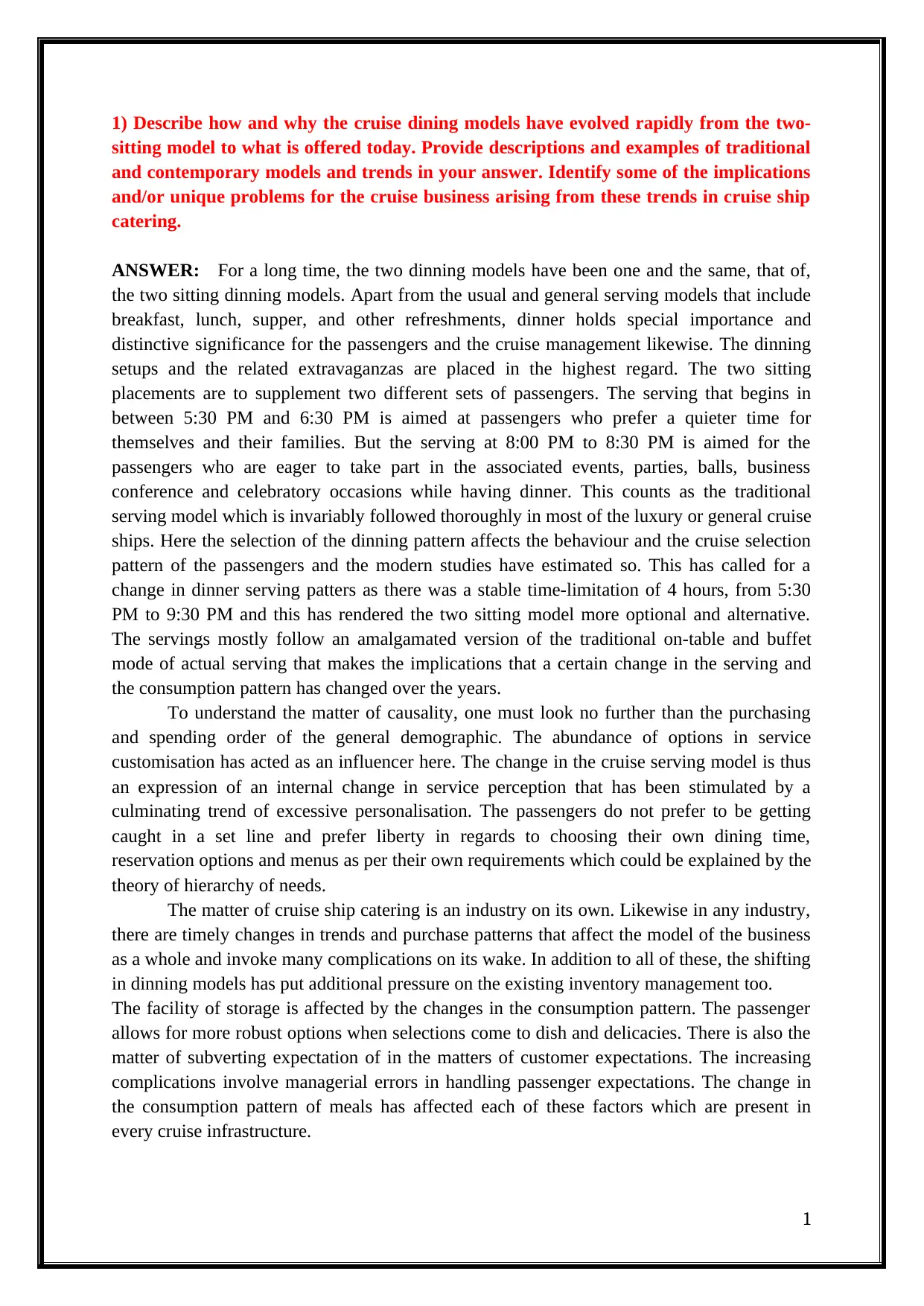
1) Describe how and why the cruise dining models have evolved rapidly from the two-
sitting model to what is offered today. Provide descriptions and examples of traditional
and contemporary models and trends in your answer. Identify some of the implications
and/or unique problems for the cruise business arising from these trends in cruise ship
catering.
ANSWER: For a long time, the two dinning models have been one and the same, that of,
the two sitting dinning models. Apart from the usual and general serving models that include
breakfast, lunch, supper, and other refreshments, dinner holds special importance and
distinctive significance for the passengers and the cruise management likewise. The dinning
setups and the related extravaganzas are placed in the highest regard. The two sitting
placements are to supplement two different sets of passengers. The serving that begins in
between 5:30 PM and 6:30 PM is aimed at passengers who prefer a quieter time for
themselves and their families. But the serving at 8:00 PM to 8:30 PM is aimed for the
passengers who are eager to take part in the associated events, parties, balls, business
conference and celebratory occasions while having dinner. This counts as the traditional
serving model which is invariably followed thoroughly in most of the luxury or general cruise
ships. Here the selection of the dinning pattern affects the behaviour and the cruise selection
pattern of the passengers and the modern studies have estimated so. This has called for a
change in dinner serving patters as there was a stable time-limitation of 4 hours, from 5:30
PM to 9:30 PM and this has rendered the two sitting model more optional and alternative.
The servings mostly follow an amalgamated version of the traditional on-table and buffet
mode of actual serving that makes the implications that a certain change in the serving and
the consumption pattern has changed over the years.
To understand the matter of causality, one must look no further than the purchasing
and spending order of the general demographic. The abundance of options in service
customisation has acted as an influencer here. The change in the cruise serving model is thus
an expression of an internal change in service perception that has been stimulated by a
culminating trend of excessive personalisation. The passengers do not prefer to be getting
caught in a set line and prefer liberty in regards to choosing their own dining time,
reservation options and menus as per their own requirements which could be explained by the
theory of hierarchy of needs.
The matter of cruise ship catering is an industry on its own. Likewise in any industry,
there are timely changes in trends and purchase patterns that affect the model of the business
as a whole and invoke many complications on its wake. In addition to all of these, the shifting
in dinning models has put additional pressure on the existing inventory management too.
The facility of storage is affected by the changes in the consumption pattern. The passenger
allows for more robust options when selections come to dish and delicacies. There is also the
matter of subverting expectation of in the matters of customer expectations. The increasing
complications involve managerial errors in handling passenger expectations. The change in
the consumption pattern of meals has affected each of these factors which are present in
every cruise infrastructure.
1
sitting model to what is offered today. Provide descriptions and examples of traditional
and contemporary models and trends in your answer. Identify some of the implications
and/or unique problems for the cruise business arising from these trends in cruise ship
catering.
ANSWER: For a long time, the two dinning models have been one and the same, that of,
the two sitting dinning models. Apart from the usual and general serving models that include
breakfast, lunch, supper, and other refreshments, dinner holds special importance and
distinctive significance for the passengers and the cruise management likewise. The dinning
setups and the related extravaganzas are placed in the highest regard. The two sitting
placements are to supplement two different sets of passengers. The serving that begins in
between 5:30 PM and 6:30 PM is aimed at passengers who prefer a quieter time for
themselves and their families. But the serving at 8:00 PM to 8:30 PM is aimed for the
passengers who are eager to take part in the associated events, parties, balls, business
conference and celebratory occasions while having dinner. This counts as the traditional
serving model which is invariably followed thoroughly in most of the luxury or general cruise
ships. Here the selection of the dinning pattern affects the behaviour and the cruise selection
pattern of the passengers and the modern studies have estimated so. This has called for a
change in dinner serving patters as there was a stable time-limitation of 4 hours, from 5:30
PM to 9:30 PM and this has rendered the two sitting model more optional and alternative.
The servings mostly follow an amalgamated version of the traditional on-table and buffet
mode of actual serving that makes the implications that a certain change in the serving and
the consumption pattern has changed over the years.
To understand the matter of causality, one must look no further than the purchasing
and spending order of the general demographic. The abundance of options in service
customisation has acted as an influencer here. The change in the cruise serving model is thus
an expression of an internal change in service perception that has been stimulated by a
culminating trend of excessive personalisation. The passengers do not prefer to be getting
caught in a set line and prefer liberty in regards to choosing their own dining time,
reservation options and menus as per their own requirements which could be explained by the
theory of hierarchy of needs.
The matter of cruise ship catering is an industry on its own. Likewise in any industry,
there are timely changes in trends and purchase patterns that affect the model of the business
as a whole and invoke many complications on its wake. In addition to all of these, the shifting
in dinning models has put additional pressure on the existing inventory management too.
The facility of storage is affected by the changes in the consumption pattern. The passenger
allows for more robust options when selections come to dish and delicacies. There is also the
matter of subverting expectation of in the matters of customer expectations. The increasing
complications involve managerial errors in handling passenger expectations. The change in
the consumption pattern of meals has affected each of these factors which are present in
every cruise infrastructure.
1
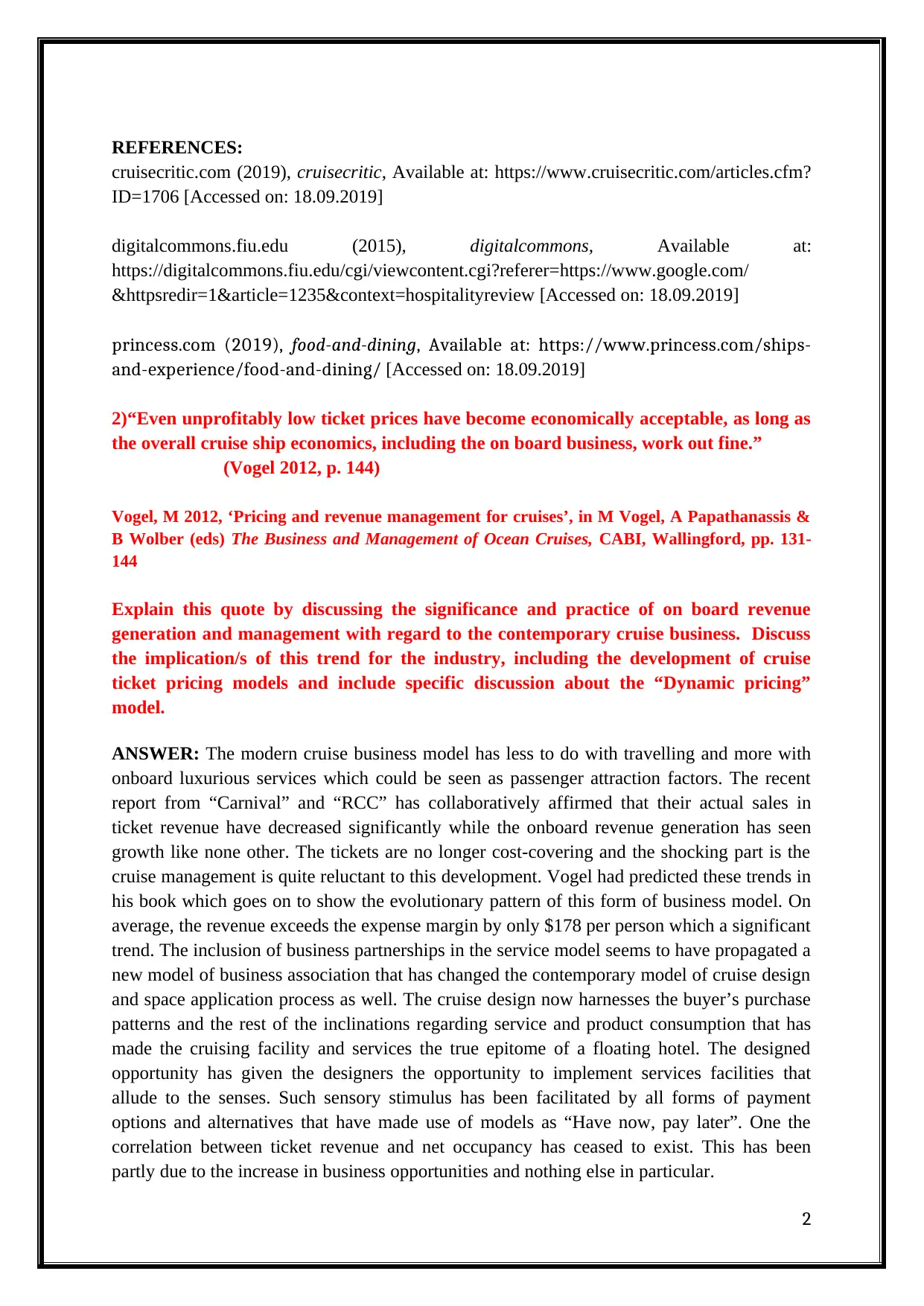
REFERENCES:
cruisecritic.com (2019), cruisecritic, Available at: https://www.cruisecritic.com/articles.cfm?
ID=1706 [Accessed on: 18.09.2019]
digitalcommons.fiu.edu (2015), digitalcommons, Available at:
https://digitalcommons.fiu.edu/cgi/viewcontent.cgi?referer=https://www.google.com/
&httpsredir=1&article=1235&context=hospitalityreview [Accessed on: 18.09.2019]
princess.com (2019), food-and-dining, Available at: https://www.princess.com/ships-
and-experience/food-and-dining/ [Accessed on: 18.09.2019]
2)“Even unprofitably low ticket prices have become economically acceptable, as long as
the overall cruise ship economics, including the on board business, work out fine.”
(Vogel 2012, p. 144)
Vogel, M 2012, ‘Pricing and revenue management for cruises’, in M Vogel, A Papathanassis &
B Wolber (eds) The Business and Management of Ocean Cruises, CABI, Wallingford, pp. 131-
144
Explain this quote by discussing the significance and practice of on board revenue
generation and management with regard to the contemporary cruise business. Discuss
the implication/s of this trend for the industry, including the development of cruise
ticket pricing models and include specific discussion about the “Dynamic pricing”
model.
ANSWER: The modern cruise business model has less to do with travelling and more with
onboard luxurious services which could be seen as passenger attraction factors. The recent
report from “Carnival” and “RCC” has collaboratively affirmed that their actual sales in
ticket revenue have decreased significantly while the onboard revenue generation has seen
growth like none other. The tickets are no longer cost-covering and the shocking part is the
cruise management is quite reluctant to this development. Vogel had predicted these trends in
his book which goes on to show the evolutionary pattern of this form of business model. On
average, the revenue exceeds the expense margin by only $178 per person which a significant
trend. The inclusion of business partnerships in the service model seems to have propagated a
new model of business association that has changed the contemporary model of cruise design
and space application process as well. The cruise design now harnesses the buyer’s purchase
patterns and the rest of the inclinations regarding service and product consumption that has
made the cruising facility and services the true epitome of a floating hotel. The designed
opportunity has given the designers the opportunity to implement services facilities that
allude to the senses. Such sensory stimulus has been facilitated by all forms of payment
options and alternatives that have made use of models as “Have now, pay later”. One the
correlation between ticket revenue and net occupancy has ceased to exist. This has been
partly due to the increase in business opportunities and nothing else in particular.
2
cruisecritic.com (2019), cruisecritic, Available at: https://www.cruisecritic.com/articles.cfm?
ID=1706 [Accessed on: 18.09.2019]
digitalcommons.fiu.edu (2015), digitalcommons, Available at:
https://digitalcommons.fiu.edu/cgi/viewcontent.cgi?referer=https://www.google.com/
&httpsredir=1&article=1235&context=hospitalityreview [Accessed on: 18.09.2019]
princess.com (2019), food-and-dining, Available at: https://www.princess.com/ships-
and-experience/food-and-dining/ [Accessed on: 18.09.2019]
2)“Even unprofitably low ticket prices have become economically acceptable, as long as
the overall cruise ship economics, including the on board business, work out fine.”
(Vogel 2012, p. 144)
Vogel, M 2012, ‘Pricing and revenue management for cruises’, in M Vogel, A Papathanassis &
B Wolber (eds) The Business and Management of Ocean Cruises, CABI, Wallingford, pp. 131-
144
Explain this quote by discussing the significance and practice of on board revenue
generation and management with regard to the contemporary cruise business. Discuss
the implication/s of this trend for the industry, including the development of cruise
ticket pricing models and include specific discussion about the “Dynamic pricing”
model.
ANSWER: The modern cruise business model has less to do with travelling and more with
onboard luxurious services which could be seen as passenger attraction factors. The recent
report from “Carnival” and “RCC” has collaboratively affirmed that their actual sales in
ticket revenue have decreased significantly while the onboard revenue generation has seen
growth like none other. The tickets are no longer cost-covering and the shocking part is the
cruise management is quite reluctant to this development. Vogel had predicted these trends in
his book which goes on to show the evolutionary pattern of this form of business model. On
average, the revenue exceeds the expense margin by only $178 per person which a significant
trend. The inclusion of business partnerships in the service model seems to have propagated a
new model of business association that has changed the contemporary model of cruise design
and space application process as well. The cruise design now harnesses the buyer’s purchase
patterns and the rest of the inclinations regarding service and product consumption that has
made the cruising facility and services the true epitome of a floating hotel. The designed
opportunity has given the designers the opportunity to implement services facilities that
allude to the senses. Such sensory stimulus has been facilitated by all forms of payment
options and alternatives that have made use of models as “Have now, pay later”. One the
correlation between ticket revenue and net occupancy has ceased to exist. This has been
partly due to the increase in business opportunities and nothing else in particular.
2
⊘ This is a preview!⊘
Do you want full access?
Subscribe today to unlock all pages.

Trusted by 1+ million students worldwide
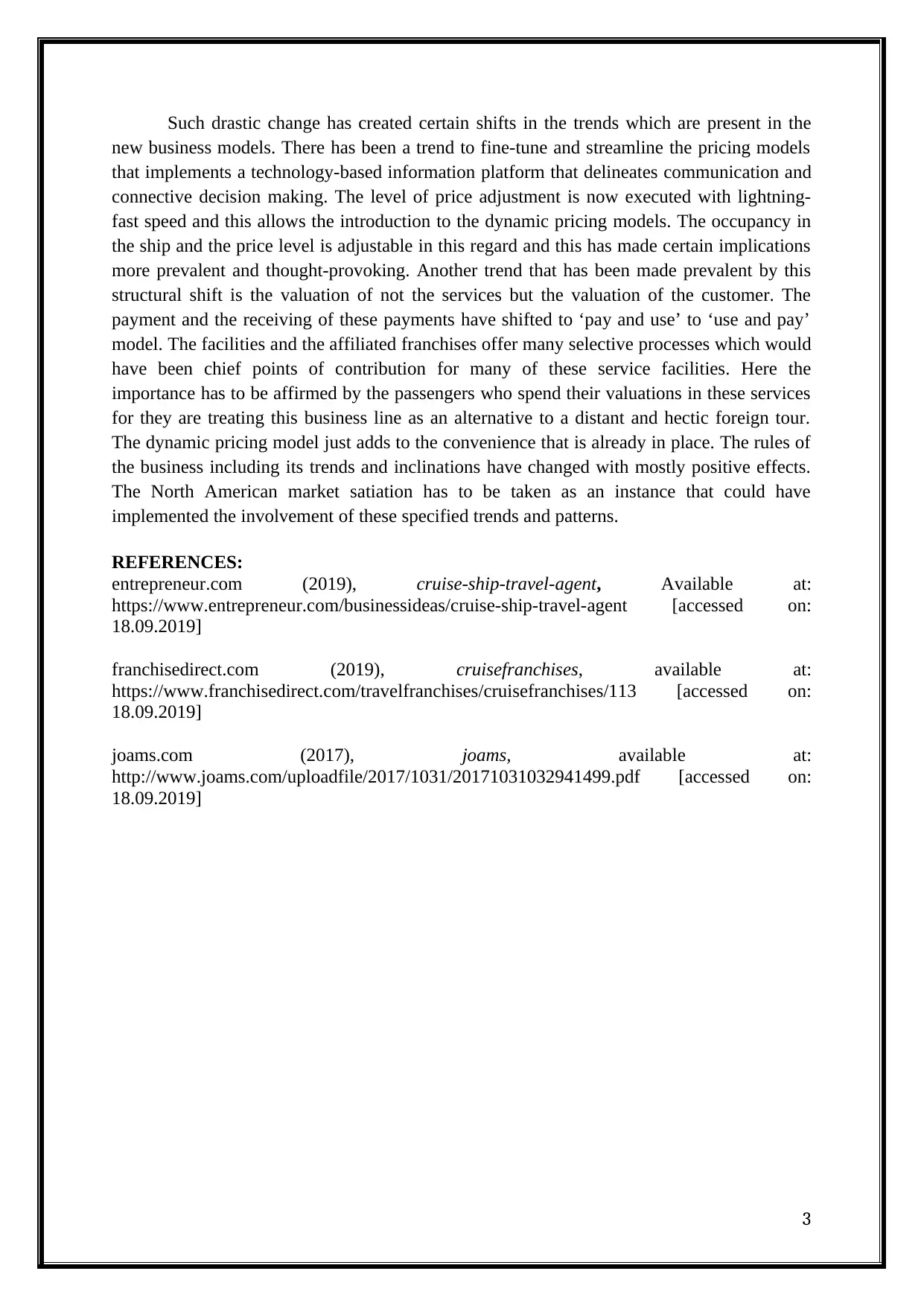
Such drastic change has created certain shifts in the trends which are present in the
new business models. There has been a trend to fine-tune and streamline the pricing models
that implements a technology-based information platform that delineates communication and
connective decision making. The level of price adjustment is now executed with lightning-
fast speed and this allows the introduction to the dynamic pricing models. The occupancy in
the ship and the price level is adjustable in this regard and this has made certain implications
more prevalent and thought-provoking. Another trend that has been made prevalent by this
structural shift is the valuation of not the services but the valuation of the customer. The
payment and the receiving of these payments have shifted to ‘pay and use’ to ‘use and pay’
model. The facilities and the affiliated franchises offer many selective processes which would
have been chief points of contribution for many of these service facilities. Here the
importance has to be affirmed by the passengers who spend their valuations in these services
for they are treating this business line as an alternative to a distant and hectic foreign tour.
The dynamic pricing model just adds to the convenience that is already in place. The rules of
the business including its trends and inclinations have changed with mostly positive effects.
The North American market satiation has to be taken as an instance that could have
implemented the involvement of these specified trends and patterns.
REFERENCES:
entrepreneur.com (2019), cruise-ship-travel-agent, Available at:
https://www.entrepreneur.com/businessideas/cruise-ship-travel-agent [accessed on:
18.09.2019]
franchisedirect.com (2019), cruisefranchises, available at:
https://www.franchisedirect.com/travelfranchises/cruisefranchises/113 [accessed on:
18.09.2019]
joams.com (2017), joams, available at:
http://www.joams.com/uploadfile/2017/1031/20171031032941499.pdf [accessed on:
18.09.2019]
3
new business models. There has been a trend to fine-tune and streamline the pricing models
that implements a technology-based information platform that delineates communication and
connective decision making. The level of price adjustment is now executed with lightning-
fast speed and this allows the introduction to the dynamic pricing models. The occupancy in
the ship and the price level is adjustable in this regard and this has made certain implications
more prevalent and thought-provoking. Another trend that has been made prevalent by this
structural shift is the valuation of not the services but the valuation of the customer. The
payment and the receiving of these payments have shifted to ‘pay and use’ to ‘use and pay’
model. The facilities and the affiliated franchises offer many selective processes which would
have been chief points of contribution for many of these service facilities. Here the
importance has to be affirmed by the passengers who spend their valuations in these services
for they are treating this business line as an alternative to a distant and hectic foreign tour.
The dynamic pricing model just adds to the convenience that is already in place. The rules of
the business including its trends and inclinations have changed with mostly positive effects.
The North American market satiation has to be taken as an instance that could have
implemented the involvement of these specified trends and patterns.
REFERENCES:
entrepreneur.com (2019), cruise-ship-travel-agent, Available at:
https://www.entrepreneur.com/businessideas/cruise-ship-travel-agent [accessed on:
18.09.2019]
franchisedirect.com (2019), cruisefranchises, available at:
https://www.franchisedirect.com/travelfranchises/cruisefranchises/113 [accessed on:
18.09.2019]
joams.com (2017), joams, available at:
http://www.joams.com/uploadfile/2017/1031/20171031032941499.pdf [accessed on:
18.09.2019]
3
Paraphrase This Document
Need a fresh take? Get an instant paraphrase of this document with our AI Paraphraser
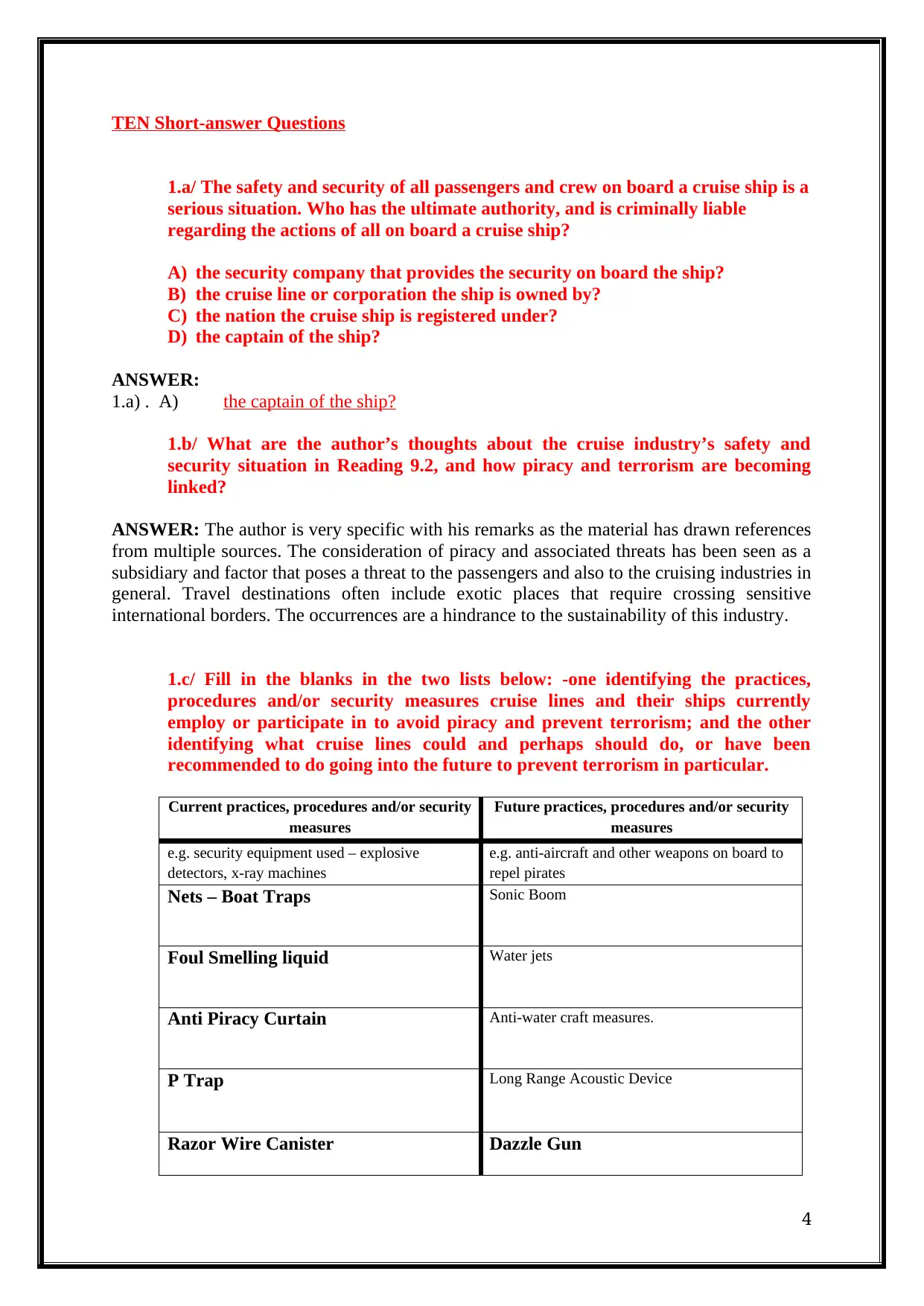
TEN Short-answer Questions
1.a/ The safety and security of all passengers and crew on board a cruise ship is a
serious situation. Who has the ultimate authority, and is criminally liable
regarding the actions of all on board a cruise ship?
A) the security company that provides the security on board the ship?
B) the cruise line or corporation the ship is owned by?
C) the nation the cruise ship is registered under?
D) the captain of the ship?
ANSWER:
1.a) . A) the captain of the ship?
1.b/ What are the author’s thoughts about the cruise industry’s safety and
security situation in Reading 9.2, and how piracy and terrorism are becoming
linked?
ANSWER: The author is very specific with his remarks as the material has drawn references
from multiple sources. The consideration of piracy and associated threats has been seen as a
subsidiary and factor that poses a threat to the passengers and also to the cruising industries in
general. Travel destinations often include exotic places that require crossing sensitive
international borders. The occurrences are a hindrance to the sustainability of this industry.
1.c/ Fill in the blanks in the two lists below: -one identifying the practices,
procedures and/or security measures cruise lines and their ships currently
employ or participate in to avoid piracy and prevent terrorism; and the other
identifying what cruise lines could and perhaps should do, or have been
recommended to do going into the future to prevent terrorism in particular.
Current practices, procedures and/or security
measures
Future practices, procedures and/or security
measures
e.g. security equipment used – explosive
detectors, x-ray machines
e.g. anti-aircraft and other weapons on board to
repel pirates
Nets – Boat Traps Sonic Boom
Foul Smelling liquid Water jets
Anti Piracy Curtain Anti-water craft measures.
P Trap Long Range Acoustic Device
Razor Wire Canister Dazzle Gun
4
1.a/ The safety and security of all passengers and crew on board a cruise ship is a
serious situation. Who has the ultimate authority, and is criminally liable
regarding the actions of all on board a cruise ship?
A) the security company that provides the security on board the ship?
B) the cruise line or corporation the ship is owned by?
C) the nation the cruise ship is registered under?
D) the captain of the ship?
ANSWER:
1.a) . A) the captain of the ship?
1.b/ What are the author’s thoughts about the cruise industry’s safety and
security situation in Reading 9.2, and how piracy and terrorism are becoming
linked?
ANSWER: The author is very specific with his remarks as the material has drawn references
from multiple sources. The consideration of piracy and associated threats has been seen as a
subsidiary and factor that poses a threat to the passengers and also to the cruising industries in
general. Travel destinations often include exotic places that require crossing sensitive
international borders. The occurrences are a hindrance to the sustainability of this industry.
1.c/ Fill in the blanks in the two lists below: -one identifying the practices,
procedures and/or security measures cruise lines and their ships currently
employ or participate in to avoid piracy and prevent terrorism; and the other
identifying what cruise lines could and perhaps should do, or have been
recommended to do going into the future to prevent terrorism in particular.
Current practices, procedures and/or security
measures
Future practices, procedures and/or security
measures
e.g. security equipment used – explosive
detectors, x-ray machines
e.g. anti-aircraft and other weapons on board to
repel pirates
Nets – Boat Traps Sonic Boom
Foul Smelling liquid Water jets
Anti Piracy Curtain Anti-water craft measures.
P Trap Long Range Acoustic Device
Razor Wire Canister Dazzle Gun
4
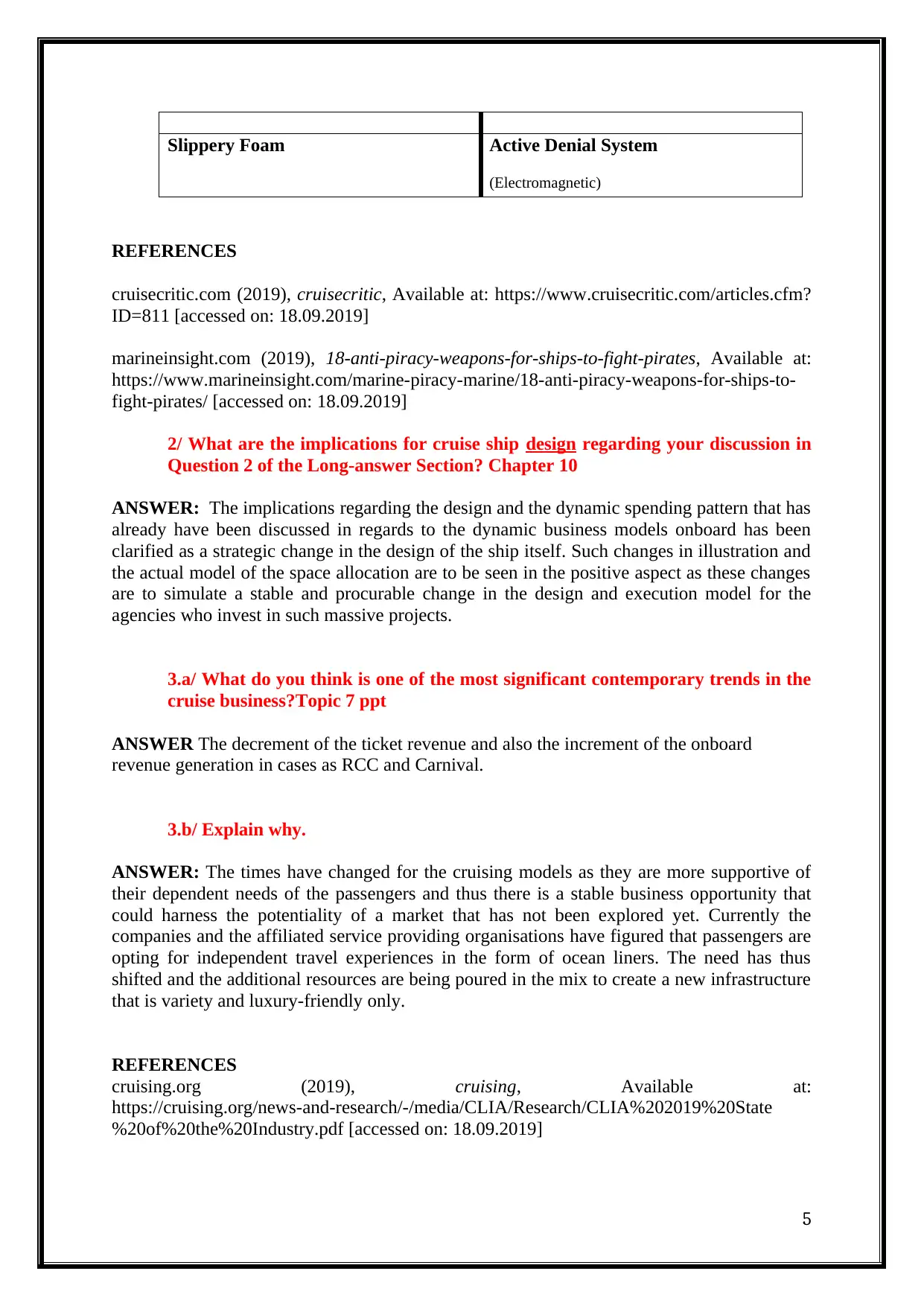
Slippery Foam Active Denial System
(Electromagnetic)
REFERENCES
cruisecritic.com (2019), cruisecritic, Available at: https://www.cruisecritic.com/articles.cfm?
ID=811 [accessed on: 18.09.2019]
marineinsight.com (2019), 18-anti-piracy-weapons-for-ships-to-fight-pirates, Available at:
https://www.marineinsight.com/marine-piracy-marine/18-anti-piracy-weapons-for-ships-to-
fight-pirates/ [accessed on: 18.09.2019]
2/ What are the implications for cruise ship design regarding your discussion in
Question 2 of the Long-answer Section? Chapter 10
ANSWER: The implications regarding the design and the dynamic spending pattern that has
already have been discussed in regards to the dynamic business models onboard has been
clarified as a strategic change in the design of the ship itself. Such changes in illustration and
the actual model of the space allocation are to be seen in the positive aspect as these changes
are to simulate a stable and procurable change in the design and execution model for the
agencies who invest in such massive projects.
3.a/ What do you think is one of the most significant contemporary trends in the
cruise business?Topic 7 ppt
ANSWER The decrement of the ticket revenue and also the increment of the onboard
revenue generation in cases as RCC and Carnival.
3.b/ Explain why.
ANSWER: The times have changed for the cruising models as they are more supportive of
their dependent needs of the passengers and thus there is a stable business opportunity that
could harness the potentiality of a market that has not been explored yet. Currently the
companies and the affiliated service providing organisations have figured that passengers are
opting for independent travel experiences in the form of ocean liners. The need has thus
shifted and the additional resources are being poured in the mix to create a new infrastructure
that is variety and luxury-friendly only.
REFERENCES
cruising.org (2019), cruising, Available at:
https://cruising.org/news-and-research/-/media/CLIA/Research/CLIA%202019%20State
%20of%20the%20Industry.pdf [accessed on: 18.09.2019]
5
(Electromagnetic)
REFERENCES
cruisecritic.com (2019), cruisecritic, Available at: https://www.cruisecritic.com/articles.cfm?
ID=811 [accessed on: 18.09.2019]
marineinsight.com (2019), 18-anti-piracy-weapons-for-ships-to-fight-pirates, Available at:
https://www.marineinsight.com/marine-piracy-marine/18-anti-piracy-weapons-for-ships-to-
fight-pirates/ [accessed on: 18.09.2019]
2/ What are the implications for cruise ship design regarding your discussion in
Question 2 of the Long-answer Section? Chapter 10
ANSWER: The implications regarding the design and the dynamic spending pattern that has
already have been discussed in regards to the dynamic business models onboard has been
clarified as a strategic change in the design of the ship itself. Such changes in illustration and
the actual model of the space allocation are to be seen in the positive aspect as these changes
are to simulate a stable and procurable change in the design and execution model for the
agencies who invest in such massive projects.
3.a/ What do you think is one of the most significant contemporary trends in the
cruise business?Topic 7 ppt
ANSWER The decrement of the ticket revenue and also the increment of the onboard
revenue generation in cases as RCC and Carnival.
3.b/ Explain why.
ANSWER: The times have changed for the cruising models as they are more supportive of
their dependent needs of the passengers and thus there is a stable business opportunity that
could harness the potentiality of a market that has not been explored yet. Currently the
companies and the affiliated service providing organisations have figured that passengers are
opting for independent travel experiences in the form of ocean liners. The need has thus
shifted and the additional resources are being poured in the mix to create a new infrastructure
that is variety and luxury-friendly only.
REFERENCES
cruising.org (2019), cruising, Available at:
https://cruising.org/news-and-research/-/media/CLIA/Research/CLIA%202019%20State
%20of%20the%20Industry.pdf [accessed on: 18.09.2019]
5
⊘ This is a preview!⊘
Do you want full access?
Subscribe today to unlock all pages.

Trusted by 1+ million students worldwide
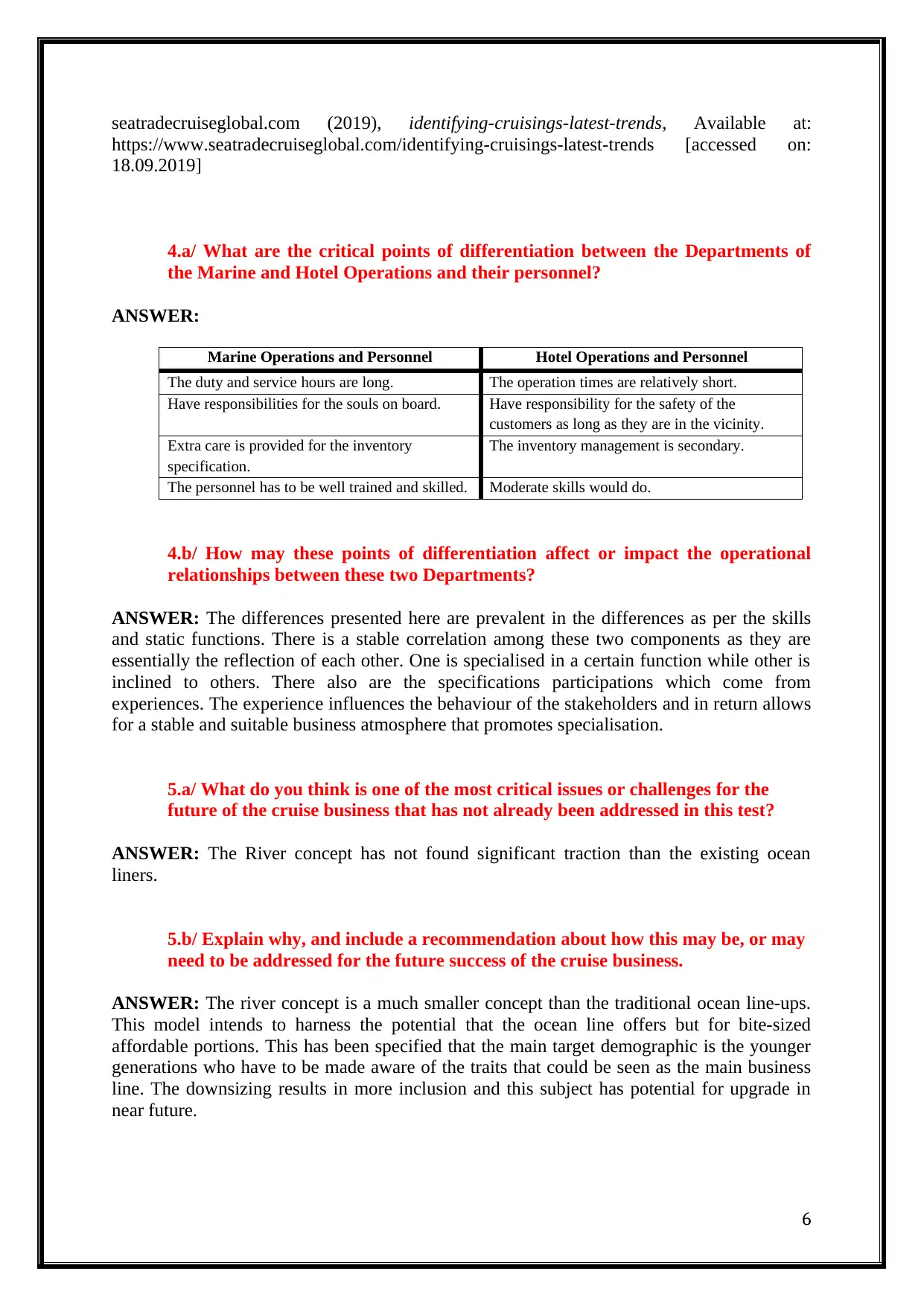
seatradecruiseglobal.com (2019), identifying-cruisings-latest-trends, Available at:
https://www.seatradecruiseglobal.com/identifying-cruisings-latest-trends [accessed on:
18.09.2019]
4.a/ What are the critical points of differentiation between the Departments of
the Marine and Hotel Operations and their personnel?
ANSWER:
Marine Operations and Personnel Hotel Operations and Personnel
The duty and service hours are long. The operation times are relatively short.
Have responsibilities for the souls on board. Have responsibility for the safety of the
customers as long as they are in the vicinity.
Extra care is provided for the inventory
specification.
The inventory management is secondary.
The personnel has to be well trained and skilled. Moderate skills would do.
4.b/ How may these points of differentiation affect or impact the operational
relationships between these two Departments?
ANSWER: The differences presented here are prevalent in the differences as per the skills
and static functions. There is a stable correlation among these two components as they are
essentially the reflection of each other. One is specialised in a certain function while other is
inclined to others. There also are the specifications participations which come from
experiences. The experience influences the behaviour of the stakeholders and in return allows
for a stable and suitable business atmosphere that promotes specialisation.
5.a/ What do you think is one of the most critical issues or challenges for the
future of the cruise business that has not already been addressed in this test?
ANSWER: The River concept has not found significant traction than the existing ocean
liners.
5.b/ Explain why, and include a recommendation about how this may be, or may
need to be addressed for the future success of the cruise business.
ANSWER: The river concept is a much smaller concept than the traditional ocean line-ups.
This model intends to harness the potential that the ocean line offers but for bite-sized
affordable portions. This has been specified that the main target demographic is the younger
generations who have to be made aware of the traits that could be seen as the main business
line. The downsizing results in more inclusion and this subject has potential for upgrade in
near future.
6
https://www.seatradecruiseglobal.com/identifying-cruisings-latest-trends [accessed on:
18.09.2019]
4.a/ What are the critical points of differentiation between the Departments of
the Marine and Hotel Operations and their personnel?
ANSWER:
Marine Operations and Personnel Hotel Operations and Personnel
The duty and service hours are long. The operation times are relatively short.
Have responsibilities for the souls on board. Have responsibility for the safety of the
customers as long as they are in the vicinity.
Extra care is provided for the inventory
specification.
The inventory management is secondary.
The personnel has to be well trained and skilled. Moderate skills would do.
4.b/ How may these points of differentiation affect or impact the operational
relationships between these two Departments?
ANSWER: The differences presented here are prevalent in the differences as per the skills
and static functions. There is a stable correlation among these two components as they are
essentially the reflection of each other. One is specialised in a certain function while other is
inclined to others. There also are the specifications participations which come from
experiences. The experience influences the behaviour of the stakeholders and in return allows
for a stable and suitable business atmosphere that promotes specialisation.
5.a/ What do you think is one of the most critical issues or challenges for the
future of the cruise business that has not already been addressed in this test?
ANSWER: The River concept has not found significant traction than the existing ocean
liners.
5.b/ Explain why, and include a recommendation about how this may be, or may
need to be addressed for the future success of the cruise business.
ANSWER: The river concept is a much smaller concept than the traditional ocean line-ups.
This model intends to harness the potential that the ocean line offers but for bite-sized
affordable portions. This has been specified that the main target demographic is the younger
generations who have to be made aware of the traits that could be seen as the main business
line. The downsizing results in more inclusion and this subject has potential for upgrade in
near future.
6
Paraphrase This Document
Need a fresh take? Get an instant paraphrase of this document with our AI Paraphraser
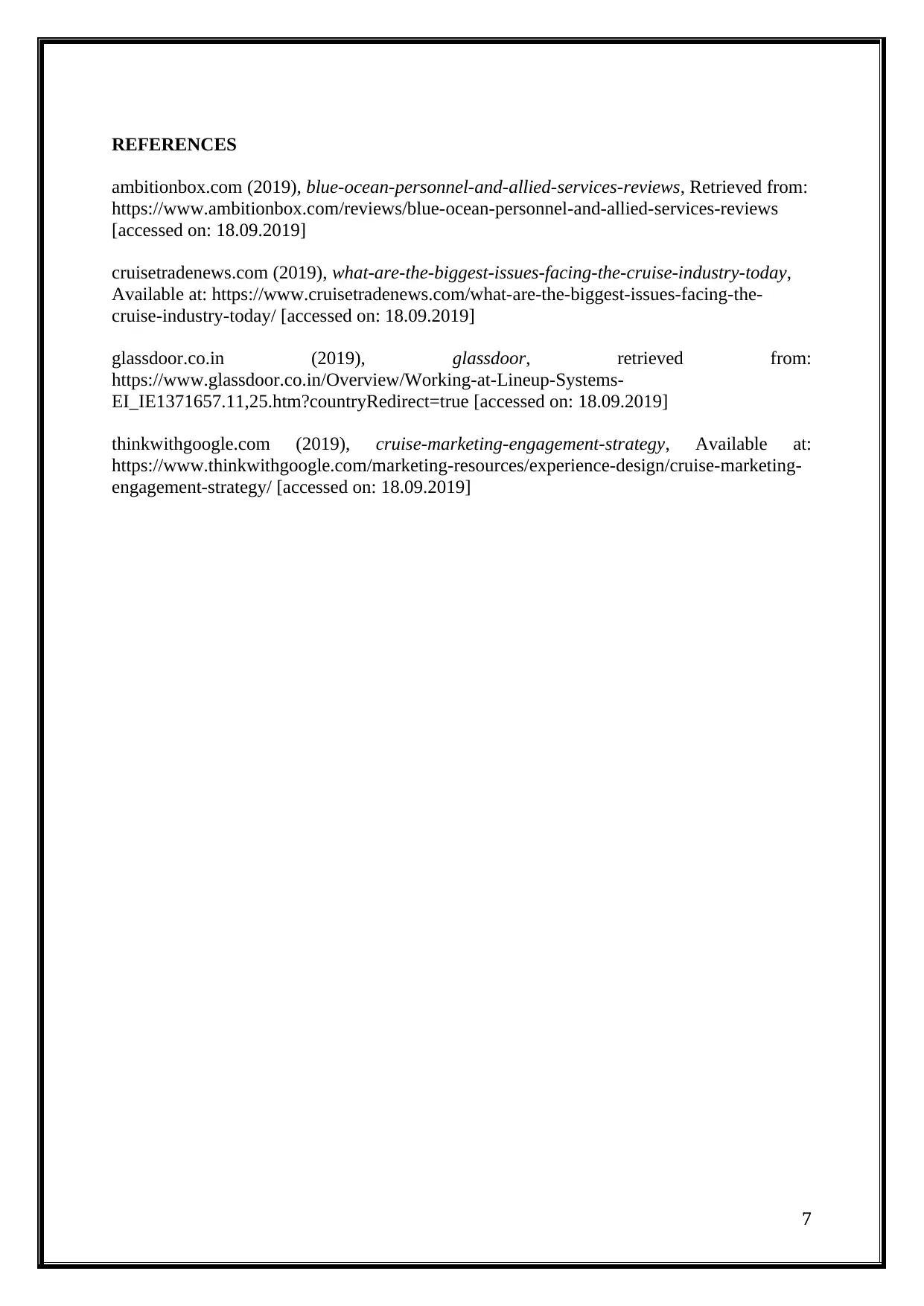
REFERENCES
ambitionbox.com (2019), blue-ocean-personnel-and-allied-services-reviews, Retrieved from:
https://www.ambitionbox.com/reviews/blue-ocean-personnel-and-allied-services-reviews
[accessed on: 18.09.2019]
cruisetradenews.com (2019), what-are-the-biggest-issues-facing-the-cruise-industry-today,
Available at: https://www.cruisetradenews.com/what-are-the-biggest-issues-facing-the-
cruise-industry-today/ [accessed on: 18.09.2019]
glassdoor.co.in (2019), glassdoor, retrieved from:
https://www.glassdoor.co.in/Overview/Working-at-Lineup-Systems-
EI_IE1371657.11,25.htm?countryRedirect=true [accessed on: 18.09.2019]
thinkwithgoogle.com (2019), cruise-marketing-engagement-strategy, Available at:
https://www.thinkwithgoogle.com/marketing-resources/experience-design/cruise-marketing-
engagement-strategy/ [accessed on: 18.09.2019]
7
ambitionbox.com (2019), blue-ocean-personnel-and-allied-services-reviews, Retrieved from:
https://www.ambitionbox.com/reviews/blue-ocean-personnel-and-allied-services-reviews
[accessed on: 18.09.2019]
cruisetradenews.com (2019), what-are-the-biggest-issues-facing-the-cruise-industry-today,
Available at: https://www.cruisetradenews.com/what-are-the-biggest-issues-facing-the-
cruise-industry-today/ [accessed on: 18.09.2019]
glassdoor.co.in (2019), glassdoor, retrieved from:
https://www.glassdoor.co.in/Overview/Working-at-Lineup-Systems-
EI_IE1371657.11,25.htm?countryRedirect=true [accessed on: 18.09.2019]
thinkwithgoogle.com (2019), cruise-marketing-engagement-strategy, Available at:
https://www.thinkwithgoogle.com/marketing-resources/experience-design/cruise-marketing-
engagement-strategy/ [accessed on: 18.09.2019]
7
1 out of 8
Your All-in-One AI-Powered Toolkit for Academic Success.
+13062052269
info@desklib.com
Available 24*7 on WhatsApp / Email
![[object Object]](/_next/static/media/star-bottom.7253800d.svg)
Unlock your academic potential
Copyright © 2020–2025 A2Z Services. All Rights Reserved. Developed and managed by ZUCOL.


